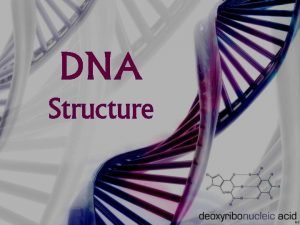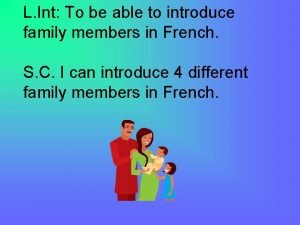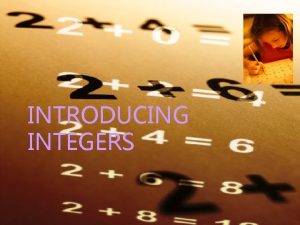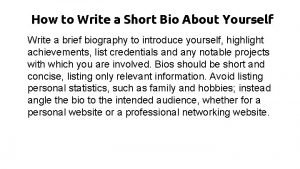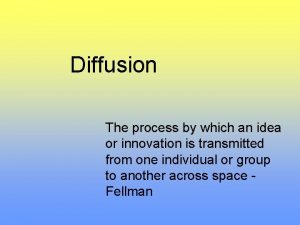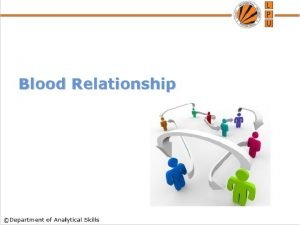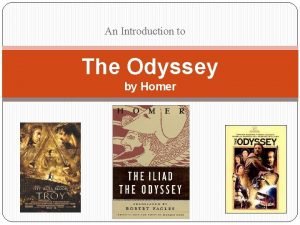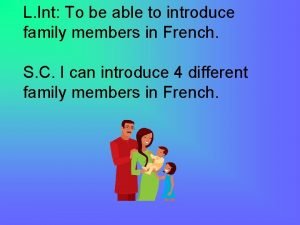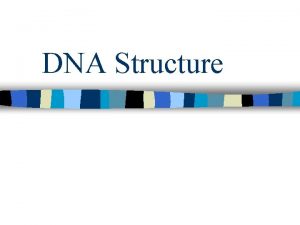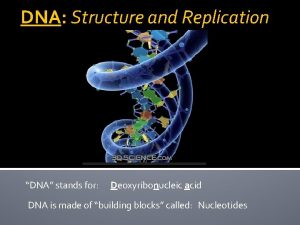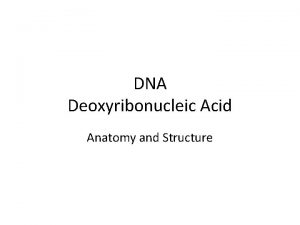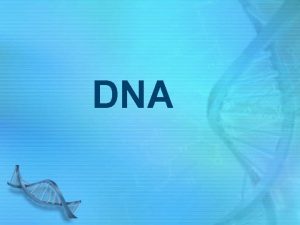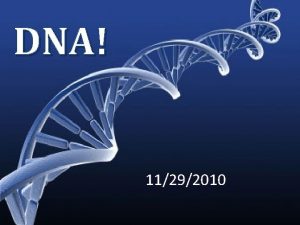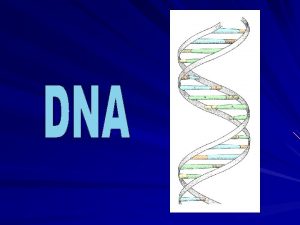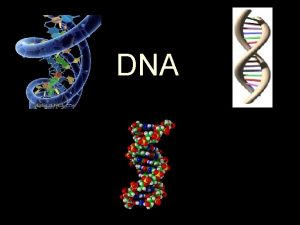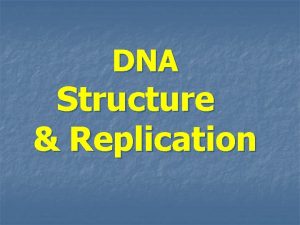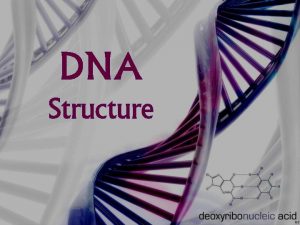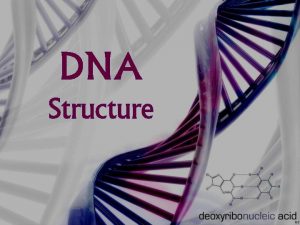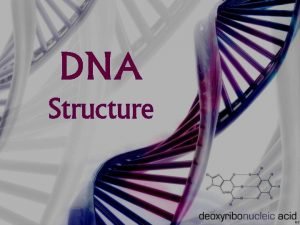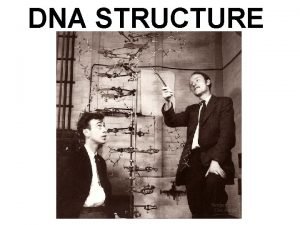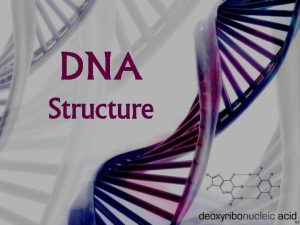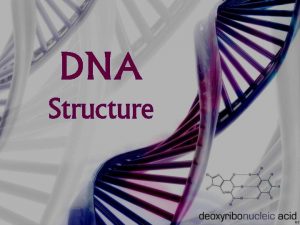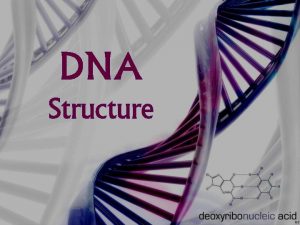Introducing DNA Structure of DNA l DNA stands




























- Slides: 28

Introducing: DNA

Structure of DNA l DNA stands for Deoxyribonucleic Acid l The primary function of DNA is to store and transmit the genetic information that tells cells WHICH proteins to make and WHEN to make them. l Each segment of DNA that codes for a particular protein is called a GENE.

Your Turn ! • Put the following terms in order from largest to smallest: Gene § Protein § DNA §

Structure of DNA l DNA is made up of repeating subunits called nucleotides. NUCLEOTIDE

Parts of a Nucleotide: A sugar molecule called deoxyribose 2. A phosphate group 3. A nitrogen base 1. Nitrogen Base Phosphate Sugar-deoxyribose

Your Turn ! • How many nucleotides are shown in this DNA segment?

Your Turn ! • Compare and contrast the DNA nucleotides.

Parts of a Nucleotide: l The deoxyribose sugar and the phosphate group are the same in ALL DNA nucleotides. l However, the nitrogen base can be 1 of 4 different bases.

Nitrogen Bases Found in Nucleotides: 1. Adenine (A) 2. Guanine (G) 3. Cytosine (C) 4. Thymine (T)

Things to notice about the Nitrogen bases… l Adenine and guanine have 2 rings of carbon and nitrogen atoms l Bases with 2 rings are called PURINES. l Thymine and cytosine have only 1 ring of carbon and nitrogen atoms l Bases with 1 ring are called PYRIMIDINES.

The Shape of DNA Molecules… l In 1953 a model of DNA was proposed by James Watson and Francis Crick. l Their model was based on research conducted by Rosalind Franklin in 1952. l The model: DNA is composed of 2 nucleotide chains that wrap around each other creating a shape similar to a spiral staircase l This shape is called a DOUBLE HELIX.


Your Turn ! • Why is DNA considered a double helix?

The Shape of DNA Molecules…

How the bases “stick” together… l The individual nucleotides are connected by COVALENT BONDS between the deoxyribose sugar and the phosphate molecules. l This creates the “backbone” to which the nitrogen bases attach.

How the bases “stick” together… l The nitrogen bases can then form HYDROGEN BONDS creating the “rungs” to the ladder.

Your Turn ! • Covalent bonds are relatively strong bonds, and hydrogen bonds can be easily broken. • What does that mean about the direction in which DNA can be separated into two strands?

Base Pairing Which bases can bond together? l DNA nucleotides pair into what are called COMPLIMENTARY BASE PAIRS. l There are 2 base-pairing rules: Cytosine bonds with Guanine 2. Adenine bonds with Thymine 1.

Your Turn ! • What bases would pair with the following bases: Adenine - ? § Guanine - ? § Cytosine - ? § Thymine - ? §

Base Pairing…

DNA in Our Bodies: l Found in the nucleus. l The DNA is coiled around proteins. We call DNA in this state chromosomes. l Humans have 23 pairs of chromosomes

Your Turn ! • Put the following terms in order from largest to smallest: Protein § Gene § Chromosome § DNA §


DNA Replication: Before a cell divides, it duplicates its DNA in a copying process called DNA replication. l Steps of DNA replication: l The enzyme helicase separates (“unzips”) the DNA molecule into 2 strands 2. Two new complimentary strands are built by the enzyme DNA polymerase following the base pairing rules 1.

Your Turn ! • What is meant by a complimentary strand? • What is the complimentary DNA strand for the segment below?

DNA Replication: l Each strand of the double helix of DNA serves as a template, or model, for the new strand. l The principle enzyme involved in DNA replication is called DNA polymerase. l It also “proofreads” the DNA to minimize mistakes

Your Turn ! • After DNA replication how many complete strands of DNA do you end up with? • Draw the following DNA segment after replication and indicate which part is the old strand which is new strand.

DNA Replication:
 Dna stands for deoxyribonucleic acid
Dna stands for deoxyribonucleic acid Dna stands for
Dna stands for The d in dna stands for
The d in dna stands for Dnac appliance
Dnac appliance Signal phrases for quotes
Signal phrases for quotes Introducing phonology answer key
Introducing phonology answer key 1941-1882
1941-1882 How to introduce a quote sentence starters
How to introduce a quote sentence starters Introducing counterclaim
Introducing counterclaim Introduce yourself sample
Introduce yourself sample Warm up introducing yourself
Warm up introducing yourself Ma
Ma Rondeau example
Rondeau example Introduction of
Introduction of Kfc is a company
Kfc is a company Opposite numbers definition
Opposite numbers definition Mpls internet access
Mpls internet access Quote starters
Quote starters Introducing new market offerings
Introducing new market offerings They say i say moves that matter in academic writing
They say i say moves that matter in academic writing Define upgrade advisor
Define upgrade advisor Introducing the metric system
Introducing the metric system Bio about your self
Bio about your self Stimulus diffusion definition
Stimulus diffusion definition Blood relationship
Blood relationship Introducing the odyssey
Introducing the odyssey A letter to an exchange student
A letter to an exchange student Carrying broker
Carrying broker Int family
Int family

